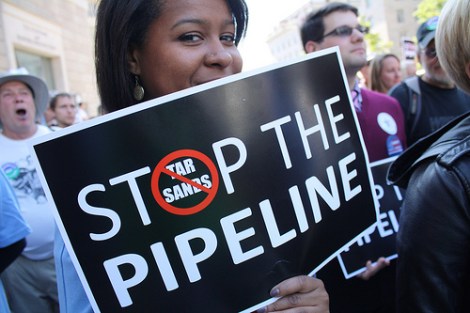Hey, guess what? TransCanada just got final approval to build its pipeline from the tar sands of Alberta all the way to the Gulf Coast of Texas. Done and done.
I know, I know: The Keystone XL pipeline has been held up. You protested at the White House to stop it. That’s cool. But what you may not know is that Keystone XL would augment a section of pipeline that already brings tar-sands oil from Canada to Nebraska. On Friday, the Army Corps of Engineers signed off on the last permits TransCanada needed for a still-empty stretch from there to the Gulf Coast. Which means that the company will soon have a complete shunt traversing the entire height of the United States.
President Barack Obama encouraged TransCanada to move ahead with the segment that will run from a refinery in Cushing, Okla. to Texas after he rejected the broader [Keystone XL] plan, saying the pipeline needed to be rerouted around Nebraska’s sensitive Sand Hills region. For that project, TransCanada needs presidential approval because it crosses an international border. The shorter portion only requires permits from state and federal agencies. TransCanada said the final of three permits it needed from the Army Corps of Engineers had been approved. …
The line from Cushing will help relieve a bottleneck at the Oklahoma refinery, but doesn’t fulfill TransCanada’s broader goal of transporting more Canadian crude to U.S. refineries.
The key word there is “more.” Transporting more Canadian crude.
Here’s what TransCanada’s grand, oily vision for North America looks like, via Inside Climate News.

Click to embiggen. (Image courtesy of Inside Climate News.)
That purple line is Keystone XL. If built, it would carry 830,000 barrels of tar-sands oil a day from Alberta to Steele City, Neb. — some 1,179 miles. But see that snaky yellow line? That’s Keystone I (which looks like this). It runs 2,147 miles, carrying 591,000 barrels a day. It goes to Steele City already. Then another Keystone leg connects it to Cushing. And now, thanks to the Army Corps of Engineers, TransCanada will soon have a route that slides on down to the Gulf Coast.
The New York Times ran an editorial this morning, suggesting that Keystone XL — now a policy zombie groaning its way through the Capitol — be killed once and for all.
[T]he climate question must be addressed, if only to give a full accounting of the range of consequences of developing the tar sands, an effort in which the United States will be complicit if it allows the pipeline. That includes the effect of destroying 740,000 acres of boreal forest (a vital sink for greenhouse gases); the carbon dioxide and other greenhouse gases emitted in extracting the oil from the tar sands (a highly energy-intensive process); and the gases emitted by burning the oil. …
We hope, of course, that the State Department is rigorous in addressing all relevant questions: whether America needs this oil now or in the future; how many jobs the pipeline will actually provide. The department will also be asking about the danger of oil spills. But its report will be incomplete if it does not also consider what the oil flowing through the Keystone XL would spill into the skies — both now and in the future.
All true! There are a ton of reasons to stop the Keystone pipeline! But from TransCanada’s end, the main thing a delay on Keystone XL means is that they’re shipping less tar-sands oil than they want, and it’s taking longer. It’s like giving a getaway driver a Honda Civic instead of a Porsche. He’d really rather be going faster, but rest assured — he’s still going to get away.

Photo by Elvert Barnes.



